Featured Panoramic Photo Above:
Classic Charles Conlon photo of Ty Cobb sliding into Jimmy Austin
Baseball History Comes Alive Now Ranked As a Top Five Website by Feedspot Among All Baseball History Websites and Blogs!
(Check out Feedspot's list of the Top 35 Baseball History websites and blogs)

Guest Submissions from Our Readers Always Welcome! Click for details
Scroll Down to Read Today’s Essay
Subscribe to Baseball History Comes Alive for automatic updates. As a Free Bonus, you’ll get instant access to my Special Report: Gary’s Handy Dandy World Series Reference Guide!
Today we welcome guest contributor Chuck Carlson with something a bit different: an interesting essay highlighting the surprising connection between baseball and soccer in the early twentieth century. Through this connection, baseball was exported to some Scandinavian countries. I was familiar with this due to my SABR biography of Jimmie Wilson who was a professional soccer player before becoming a major leaguer. I know all baseball history fans will find Chuck’s essay of interest. -GL
The Interesting Connection Between Early American Baseball and International Soccer
As a sports-playing fanatic growing up in the northern suburbs of Chicago, it was baseball in the spring and summer, basketball in the winter, and football in the fall, or, as we knew them, the All-American games. However, my junior high school did not have a football team; and so, as a 10-year-old, I began competing in fall interscholastic soccer games. Soccer, to me and many of my suburban friends, was either a “foreign” game (I could watch live matches on Spanish language TV), or a “brand new sport,” which had been introduced by PE teachers to keep kids running.
Fast forward 45-plus years, and, as the club historian for Chicago House Athletic Club Soccer team, I have been researching soccer history in Chicago hoping to connect soccer’s past to the soccer culture we have today. I found, as I looked back at the early decades of twentieth-century America, that baseball (softball for female athletes) and basketball were certainly the summer and winter sports of choice. The fall sport of choice for American kids was not always so apparent. In fact, soccer was so prevalent that American soccer players were actually trying to export baseball to Europe in the 1910s.
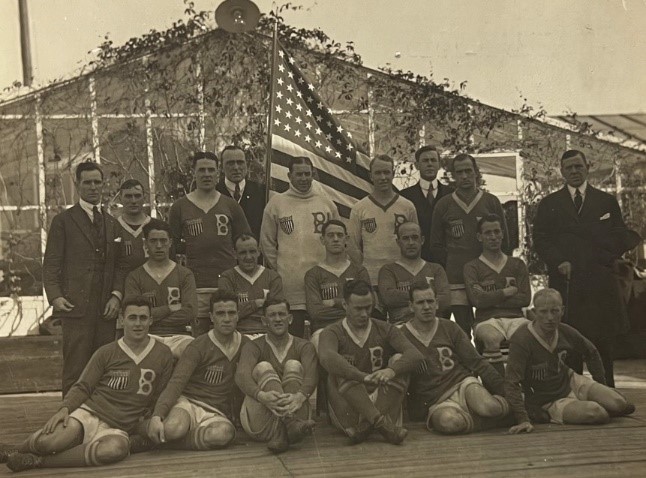
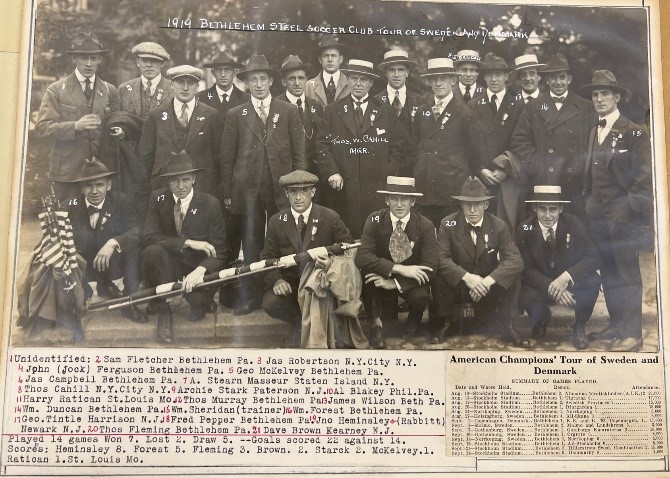
(Bethlehem Steel 1919 folder, Hap Meyer Collection, Southern Illinois University-Edwardsville)
In 1919, the best professional soccer team in the United States was a Pennsylvania team known as Bethlehem Steel. The Steelmen, who had started as Bethlehem FC in 1907, became sponsored by the Steel and Shipbuilding company in 1914. Bethlehem Steel owner Charles Schwab spent significant resources (for the time) to attract international talent. This resulted in five National Championships (called US Open Cup now but then called the US Challenge Cup) between 1915 and 1919. That dominance in American soccer competitions encouraged the Steelmen to schedule an international tour.
On July 23, 1919, more than 20 players and administrators (including a full-time masseur) boarded the Swedish-American line steamship Stockholm in New York for the journey to Gothenburg, Sweden. While we now take rapid international travel for granted, at that time it took more than ten days to get to Scandinavia. Such a long journey did have one advantage: players were able to train while traveling. With the cooperation of Stockholm Captain A.E. Hakanssen, Bethlehem Steel players had a daily training schedule from 10:30 a.m. to 3 p.m. in a space that included soccer goals.
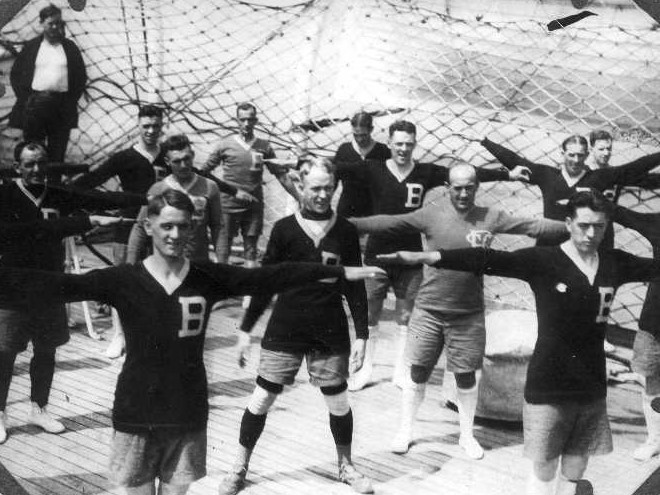
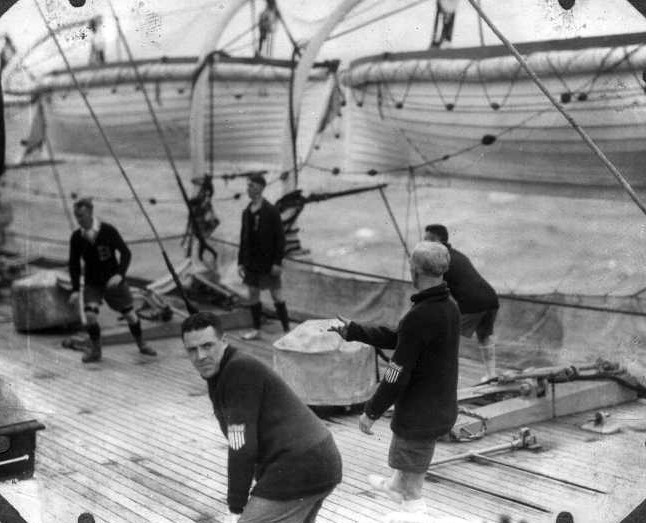
(https://web.archive.org/web/20091110174813/http://bethlehemsteelsoccer.org/scandinavia.html)
That training clearly paid off. The tourists (as they were referred to in the Swedish press) compiled a record of seven wins, two defeats, and five draws against a variety of high-level competitions over the two months in which they stayed abroad. They played in front of more than 100,000 fans, and the quality of soccer play was considered a big success by all measures. It was on the baseball diamond, however, that the Steelmen went undefeated on this tour.
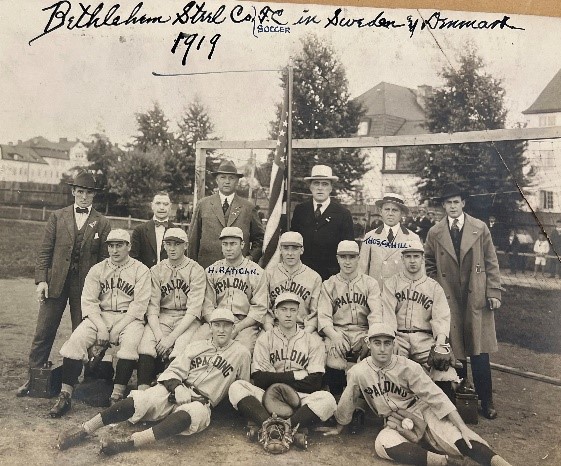
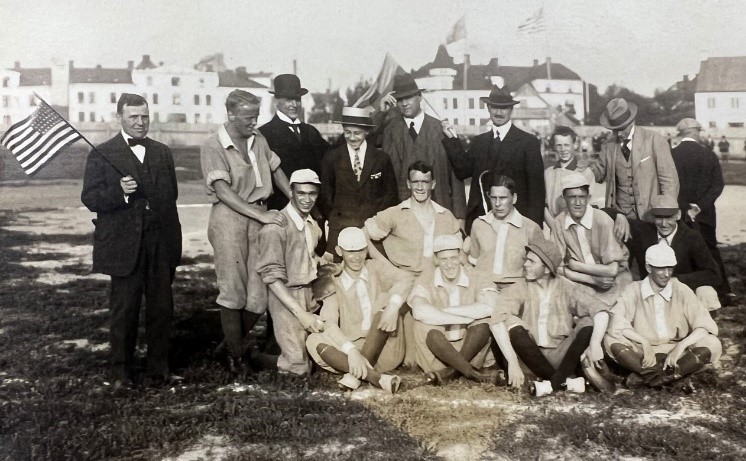
(Bethlehem Steel 1919 folder, Hap Meyer Collection, Southern Illinois University-Edwardsville, 2nd photo is Vastras, Swedish team)
Playing as the “Spaldings”—their equipment was donated by A.G. Spalding & Bros.—the Steelmen were 3-0 against surprisingly tough Swedish competition. While the sports of soccer and baseball clearly require significantly different skill sets, this particular team of soccer players was equal to “a team classing with the better semi-pro nines of the east,” according to the New York Tribune (20 July 1919 p. 19).
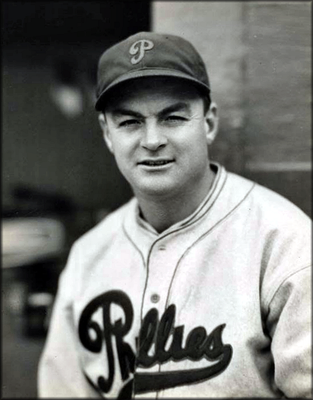
St. Louis product Harry Ratican, who would go on to earn soccer Hall of Fame status, was also a “skilled infielder,” and played minor league baseball for the Quincy, Illinois Three-Eye League team. If the full complement of Bethlehem Steel baseball/soccer players had gone on this tour, the final scores of those baseball games may not have been so close for the Swedish teams. Jimmie Wilson, who later became a major leaguer and Cub manager, was scheduled to join Bethlehem Steel in Scandinavia but elected to visit his relatives in Scotland instead of going to Sweden.
As innovative as that 1919 Bethlehem Steel tour was, it was not the first effort to promote baseball in Scandinavia by American soccer teams. In 1916, when the United States Men’s National Soccer team took their first ever foreign soccer tour, they were also promoting baseball. That 1916 team included future major leaguer C.H. “Dick” Spalding who would play for Philadelphia and Washington in the 1920s.
To give an idea of how important baseball was, one can look at the equipment that the 1916 team brought from the US to Sweden: three soccer balls and, “three dozen National League baseballs, one catcher’s mitt, one catcher’s mask, one body protector, nine infielders and outfielders gloves, one first baseman’s mitt, one set of bases and nine bats.” (“The All American Tour of Norway and Sweden, Hap Meyer Collection, Southern Illinois University-Edwardsville).
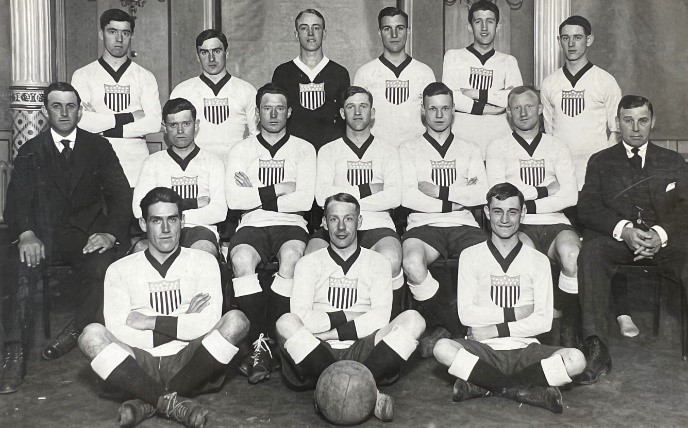
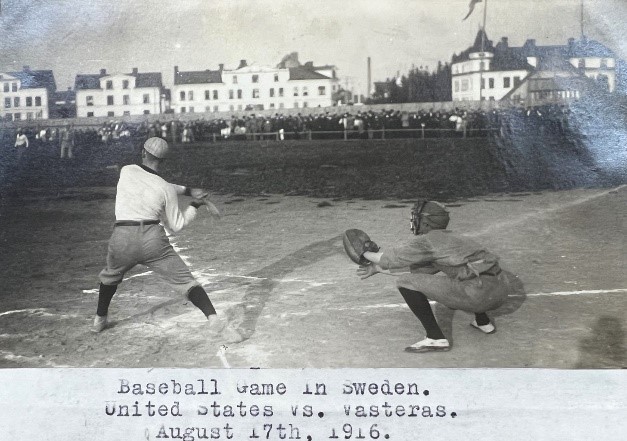
(USA 1916 Tour, Hap Meyer Collection, Southern Illinois University-Edwardsville)
At the turn of the century and into the early 1920s one might say it was baseball, basketball and soccer that defined the American sporting landscape. It is, therefore, not completely surprising that as American soccer teams engaged the international community in soccer matches, they would also include the American Pastime as part of their travels. Efforts to export baseball to Europe were not as successful as they were in the Caribbean and East Asia (namely Japan and Korea). The fact that American-based soccer players were good enough to compete abroad with other soccer-playing countries (the US men finished fourth at first ever World Cup in 1930) while also trying to export our national game is an area of baseball research one might not expect to find.
Chuck Carlson
Subscribe to our website, “Baseball History Comes Alive!” with over 1200 fully categorized baseball essays and photo galleries, now closing in on the one million hits mark with 987K hits and over 800 subscribers: https://wp.me/P7a04E-2he


Great info Chuck! Do you have any info on connections between American baseball tours and the Finnish sport of Pesäpallo which resembles baseball?
It was developed by Lauri “Tahko” Pihkala, but I don’t know where he got his obvious baseball inspirations.
Thanks for the info, Peter…I had never heard of that before.